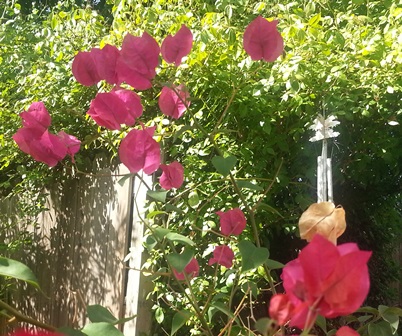Plant Dahlias and Canna Lilies Now for Dazzling Summer Color
Love the tropical foliage and brilliant color of dahlia and Canna lily blooms? Plant them now through April if you live in Zones 8 through 11. Long prized as cut flowers for bouquets, dahlias and Canna lilies do not fail to dazzle also when grouped in flowerbeds alone or with other summer blooming plants.
Indigenous to Central Mexico, dahlias are herbaceous, leafy plants that offer blooms in a wide assortment of colors (except blue and black). Bloom size ranges from a couple of inches across to roughly a foot wide (the largest size is known as “dinner-plate”). Tall varieties need staking and all types can benefit from dead-heading when blooms are spent.
Dahlia roots are actually tubers and do best when planted in moist, well-drained, loamy soil. If growing them in areas where there is frost, dig and store the tubers in a cool, dry (and frost-free) place in the fall for re-planting the next year. In extreme climates like the high desert, dahlias benefit from several inches of mulch covering the bed.
The main pests of dahlias are slugs, snails, earwigs, leaf hoppers, and aphids. Powdery mildew and gray mold can also infect the plant.
Canna lilies, like dahlias, are herbaceous summer-blooming plants that come in a wide variety of colors. Indigenous to sub-tropical areas of North and South America, Cannas can be grown as perennials in zones 7 through 11, according to the U.S. Department of Agriculture. In other zones with more extreme climates, mulch the plants two to four inches deep or lift the rhizomes (roots) and store them in dry peat moss in a cool, dry place until ready to replant.
Plant rhizomes of tall Canna lilies at the back of the flowerbed (or at the front of the bed if the plants are dwarf) in three to six inches of rich, well-drained soil. Position so that the eyes are facing up. Pests include slugs, snails, Canna leaf-rollers, and Japanese beetles. Aphids can spread canna viruses that can cause leaf streaking and bloom disfigurement. The plants are heavy feeders so will need a good organic fertilizer when they begin to look ratty and two to four inches of water each week.
Use tall dahlias and Canna lilies at the back of your flowerbed and add mid-size blooming plants in the middle and dwarf or low growing bedding plants with lots of color at the front to create a spectacular garden area this summer. If you live in a relatively frost-free zone, your dahlias and Canna lilies will spring back to life and carry on with colorful displays amid tropical foliage for years to come.
__________________________________________________________________________________
If you enjoy reading about gardening and the natural world, check out my series of cozy mysteries that include information on growing heirloom plants and keeping chickens and bees. Also see my self-help empowerment and well-being books. All are available online and in bookstores everywhere.

The Henny Penny Farmette series of cozy mysteries–lots of delicious recipes and information for country living
CLICK ON THE LINK to see more.
Bougainvillea Vines Are Valued for Their Vibrant Color
If you’re looking for something that gives dense cover with green leaves and has prolific flower production, think about planting some bougainvillea vines. After my husband recently picked up four bougainvilleas in gallon-pots from our local nursery where the plants were on sale, we planted them around the front porch.
When you buy them in pots during spring and summer, you can pick bract color. The nearly inconspicuous blooms are surrounded by large, vibrantly colored bracts. Color choice ranges from red, orange, pink, fuchsia, deep purple, and white.
You’ll need to protect these evergreen shrubby vines where frost is expected. They’ll benefit from being moved to a warm wall. In fact, bougainvillea will thrive in the warmest parts of the garden. That said, they may even need a little shade protection in extremely hot areas.
Since the roots aren’t interwoven tightly in a root ball, you’ll want to plant them with care or slice the sides of your plastic gallon pot a half-dozen times, fold back, and plant pot and all in the planting hole.
Spring and summer are the best times to fertilize. Prune to renew the plant in the spring after the danger of frost is over. Many bougainvillea plants are tall growing varieties but you can also find some considered low- to medium-growing shrubs. These vines are show-stoppers with curb appeal and an even better value when you get them discounted at your local plant nursery.
 Facebook
Facebook Goodreads
Goodreads LinkedIn
LinkedIn Meera Lester
Meera Lester Twitter
Twitter







